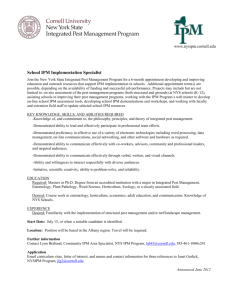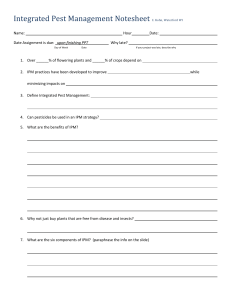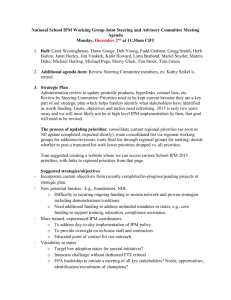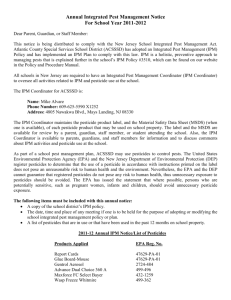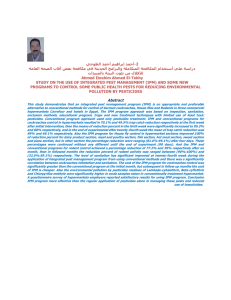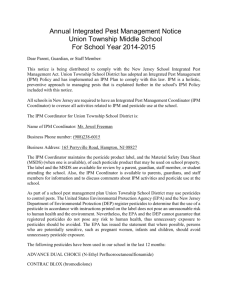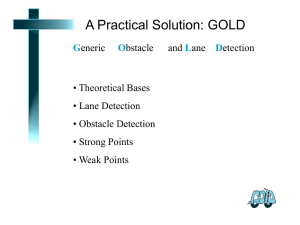National School IPM Working Group Joint Steering and Advisory
advertisement
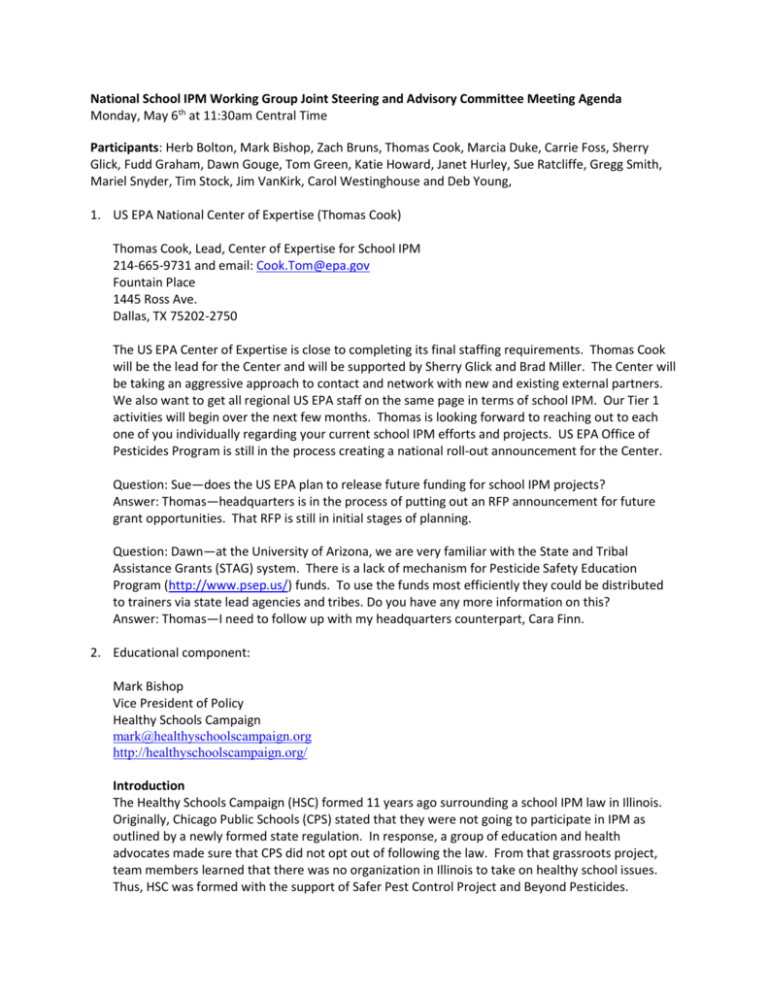
National School IPM Working Group Joint Steering and Advisory Committee Meeting Agenda Monday, May 6th at 11:30am Central Time Participants: Herb Bolton, Mark Bishop, Zach Bruns, Thomas Cook, Marcia Duke, Carrie Foss, Sherry Glick, Fudd Graham, Dawn Gouge, Tom Green, Katie Howard, Janet Hurley, Sue Ratcliffe, Gregg Smith, Mariel Snyder, Tim Stock, Jim VanKirk, Carol Westinghouse and Deb Young, 1. US EPA National Center of Expertise (Thomas Cook) Thomas Cook, Lead, Center of Expertise for School IPM 214-665-9731 and email: Cook.Tom@epa.gov Fountain Place 1445 Ross Ave. Dallas, TX 75202-2750 The US EPA Center of Expertise is close to completing its final staffing requirements. Thomas Cook will be the lead for the Center and will be supported by Sherry Glick and Brad Miller. The Center will be taking an aggressive approach to contact and network with new and existing external partners. We also want to get all regional US EPA staff on the same page in terms of school IPM. Our Tier 1 activities will begin over the next few months. Thomas is looking forward to reaching out to each one of you individually regarding your current school IPM efforts and projects. US EPA Office of Pesticides Program is still in the process creating a national roll-out announcement for the Center. Question: Sue—does the US EPA plan to release future funding for school IPM projects? Answer: Thomas—headquarters is in the process of putting out an RFP announcement for future grant opportunities. That RFP is still in initial stages of planning. Question: Dawn—at the University of Arizona, we are very familiar with the State and Tribal Assistance Grants (STAG) system. There is a lack of mechanism for Pesticide Safety Education Program (http://www.psep.us/) funds. To use the funds most efficiently they could be distributed to trainers via state lead agencies and tribes. Do you have any more information on this? Answer: Thomas—I need to follow up with my headquarters counterpart, Cara Finn. 2. Educational component: Mark Bishop Vice President of Policy Healthy Schools Campaign mark@healthyschoolscampaign.org http://healthyschoolscampaign.org/ Introduction The Healthy Schools Campaign (HSC) formed 11 years ago surrounding a school IPM law in Illinois. Originally, Chicago Public Schools (CPS) stated that they were not going to participate in IPM as outlined by a newly formed state regulation. In response, a group of education and health advocates made sure that CPS did not opt out of following the law. From that grassroots project, team members learned that there was no organization in Illinois to take on healthy school issues. Thus, HSC was formed with the support of Safer Pest Control Project and Beyond Pesticides. Currently, 50% of HSC work is national and the other 50% is focused on the Chicago region. Our organizations topics include food and fitness (asthma, supporting nutrition standards, farm to school programs, recess initiatives), green cleaning (chemical management, hand washing, IPM, IAQ), capital programs and investment in school facilities. We believe that green cleaning is not a single program but a series of steps. IPM is a strong component of that. Many of our partner schools refuse to talk about green cleaning without talking about IPM. Right now, HSC has two big national strategies. We are working on incorporating health into national policies and brainstorming ways to hold educational leaders accountable, such as making health outcomes part of job requirements. Last year, we created the “Health in Mind” publication that included recommendations on how to integrate health into school policies, including continuing education units (CEUs) for professional teachers. We continue to work on ways we change policy to include language about healthy school environments. In Illinois, we are working with the Department of Education to implement recommendations slowly. HSC has also made recommendations to the Surgeon General’s Office about how the federal government can incorporate health and wellness on federal, state and local levels. We partner with health and human services to increase health services for children (students) and adults who are eligible for Medicaid-supported services, especially services offered in schools. HSC worked with the US EPA to delivery feedback for the environmental health guidelines for schools, which seemed like repackaging of the Tools for Schools program. The guidelines included elements on what states can do from a policy and regulatory standpoint, including IPM. In next two months, HSC would like to sit down with EPA representatives and figure out how to support and roll out adoption and understanding of the health guidelines to promote better school environments. At the local level, we host an extensive parent training program to equip Latino families to work with their schools’ health and wellness programming. We are using federally required wellness teams to get parents involved in low income communities. CPS has a lack of outdoor play spaces. HSN is partnering with Chicago based orgs, including the Federal Aviation Authority and the local waste water management program to reduce heat island effect and increase play spaces for students in Chicago. Q & A: Q: Janet—Do you know anything about the whole child initiative? A: Mark—Yes, it is supported by Association for Supervision and Curriculum Development (ASCD) and we have worked with them in the past. They look at health indicators and do excellent work. They are early consultants and partners through our work and helped inform our policy initiatives. We also rely on a researcher named Charles Bosh from Columbia Research College and a study that was published a few years ago called, “Do Healthier children Learn Better,” which helped us identify academic and opportunity gaps in the schools. Q: Janet—when conducting outreach and community training, I am curious about what you are teaching parents? Does your website have trainings listed? A: Mark—on our website, there is a parents united for health schools project section. Our effort seeks to engage Latino families and schools in health and wellness. The outcomes are tremendous. Our wellness teams are improving and changing competitive food policies in schools and at home. Parents are taking lessons home and changing the ways they are cooking. We heard a fabulous story of a mother going into the catering business because of one of our community programs. Q: Carol—Regarding your teacher training material, has anything been developed in terms of curriculum for teachers? A: Mark—we do have training on health and wellness through CPS. We are thinking about how to distribute this training on a broader level. How to take health and wellness into what schools are already doing, such as incorporating movement. HSC is also developing a healthy homework program. There are lots of activities that teachers can do to get students involved in homework and being active. How teachers can create healthy homework to be sent home, such as playing outside for 30 minutes and then writing about it. Carol—New Hampshire partners for healthy schools has curriculum based on a Tools for Schools type approach. Q: Dawn— There are a number of groups working on science-based curriculum involved with hands on-science. Are there opportunities to engage and periodically be involved in developing curriculum between our school IPM group and HSN? A: Mark—Yes, we would like to be involved in such a project—whether its review or promoting curriculum. Q: Dawn—What school metrics are associated with health and wellness? We struggle with impacts, which often take years to measure. I am part of a US EPA pesticide dialogue committee that has developed metrics for health-related school environments. Any metrics that you develop, we would be interested in reviewing. One of the US EPA Tier 1 strategies is to develop some measureable outcomes for school IPM, including health and wellness measures. A: Mark—It is challenging dealing with health records. For example, Colorado is doing great research on health metrics. In Illinois, we are looking at school health policies supportive of students health. If student health information is made public, it can empower teachers or parents—that is how we originally pulled together stakeholders in Illinois. We developed a list of 19 different health policies and combined them into one matrix. We are working with state to put in school state report card. Our hope is to have a single metric rating system for specific policies. We are working through that process now and our goal is to roll formal plans in 2014 for a health policy index. IPM is on that index list, which is still in draft form. All our policies have to be developed based on existing state laws or national best policies. Q: Sue—do you have any involvement with tribal schools or other tribal opportunities? A: Mark—none, not yet. A big chunk of our work is working with CPS and national US EPA groups. Sue would like to have a side conversation about further partnerships in Illinois. 3. School IPM District Survey update (Zach & Mariel) Complete 1. ALASKA 2. ARIZONA 3. CALIFORNIA 4. COLORADO 5. CONNECTICUT 6. HAWAII 7. 8. 9. 10. 11. 12. 13. 14. 15. 16. 17. 18. 19. 20. 21. 22. 23. 24. 25. 26. 27. 28. ILLINOIS IOWA KANSAS LOUISIANA MAINE MARYLAND MINNESOTA NEVADA NEW HAMPSHIRE NEW MEXICO NEW YORK NORTH CAROLINA OREGON RHODE ISLAND SOUTH CAROLINA SOUTH DAKOTA UTAH TENNESSEE VERMONT WASHINGTON WEST VIRGINIA WYOMING IDAHO DELAWARE GEORGIA VIRGINIA NORTH DAKOTA MISSISSIPPI NEBRASKA KENTUCKY ALABAMA ARKANSAS MASSACHUSETTS WISCONSIN INDIANA MISSOURI Close to Complete 5/1, 54 out of 168 = 32% 5/1, 6 out of 19 = 32% Far from Completion 5/1, 50 out of 180 = 28% 5/1, 26 out of 128 = 20% 5/2, 40 out of 196 = 20% 5/2, 19 out of 150 = 13% 5/2, 53 out of 250 = 21% 5/1, 27 out of 174 = 15% 5/2, 2 out of 133 = 2% 5/2, 32 out of 239 = 13% 5/2, 26 out of 243 = 11% 5/1, 53 + (38) out of 424 = 21% 5/1, 76 out of 454 = 17% 5/2, 105 out of 523= 20% # Needed to reach 40% 13 2 22 24 40 41 47 42 50 58 69 79 104 105 OHIO TEXAS MONTANA PENNSYLVANIA MICHIGAN OKLAHOMA NEW JERSEY 5/2, 137 out of 615 = 22% 5/1,207 out of 1,033 = 20% 5/1, 38 out of 414 = 9% 5/1, 39 out of 501 = 7% 5/1, 40 out of 550 = 7.2% 5/2, 26 out of 523 = 5% 5/2, 72 out of 616 = 11% 113 213 127 166 185 184 4. Regulatory journal article (Tom & Janet)—Janet—almost done with the final draft. Thanks to everyone who helped submit content and review the article. We still have a few last comments from the National Pest Management Association (NPMA). Marcia Duke is the new NPMA representative, who will be sending Tom and Janet feedback in the next two weeks. Still waiting on feedback from Responsible Industry for a Sound Environment (RISE) and the Association of Structural Pest Control Regulatory Officials (ASPCRO). Dawn suggests submitting the journal for publication ASAP, as final publications are taking longer than ever (at least one year). Marcia Duke—new steering committee representative for NPMA. Maria started her professional career working for Bob Wharton at Texas A&M and completed her PhD on control of fruit flies. She then worked for Terminex doing pest control and then transitioned to the regulatory arena and registered products with SP Products and Sons. She recently joined NPMA to work on regulatory issues. IPM and school IPM will be on Marcia’s plate going forward. 5. Regional updates (group—as time permits) North Central Region - We completed our May 6th conference call this morning. John Gann of Keller Independent School District spoke on IPM and energy management. To read the minutes, please visit: http://www.ipminstitute.org/NC_IPMIS_Working_Group/main.htm Southern region - Some of you have been contacted by Janet regarding a support letter for a proposal on the IPM Cost Calculator. Please let Janet know if you have been using that tool and want to help develop its final phase. - Janet worked with New Orleans last month. Claudia has had to disqualify some schools from her project due to lack of compliance. A coalition meeting is scheduled for June and schools in Louisiana will be invited to New Orleans for a workshop. They will bring their IPM plan and we can help them write it. Ken McPherson and Marc Lame will be at the training. - Janet, Mike Merchant, and Blake Bennett toured a school in Irving, Texas that produces enough energy to sell back to the grid. They have little or no pest complaints in the school due to the efficient design of the building. To see more about this school campus check out their website Lady Bird Johnson Middle school is the largest Net Zero school in the U.S. http://irvingisd.net/education/school/school.php?sectionid=2115 - Fudd continues to work with Faith on the grant project. He is trying to get in touch with PMPs in Alabama and get schools to start using Pest Presses to train each other. - Karen Vail working on bed bug grant, which Fudd will be able to use with eXtension.org - Jerri Caldwell is working with Steven Kells (University of Minnesota) on developing bed bug resources in 7 different languages. Western region - Oregon—Tim had SIPM coordinator training where he trained 35 coordinators from 35 different school districts. He also attended the Oregon Facility Managers Association annual conference and arranged two presentations—one on indoor rodents and one on outdoor rodents. EPA IPM grant—had a change agent practicum and a strategic planning session on April 16-17 in Seattle. 27 people attend the training including members from the Washington Facility Managers Association, the Oregon Facility Managers Association, Washington Public Health Department, and the county health department. They discussed how to work together with IAQ to implement IPM, including walk-throughs and synergizing with existing efforts from the Washington Department of Agriculture. - Arizona—Dawn and team got extension grant to provide school managers and PMPs with IPM training outside of the metro areas. First one was in Prescott, AZ and had mixture of school managers, PMPs and master gardeners. This event clashed with a school nurses event, which was the same week. Dawn and team presented at two more training sessions and struggled with lower attendance rates that urban school districts. Dawn continues to work with Phoenix metro schools to develop bed bug trainings and prevention plans. - Alaska and Montana—did not have support to apply for EIPM funds. - Colorado—Deb and Clyde Wilson gave presentation to Colorado Alliance of Educators. - Washington—working with King County who is translating extension materials for IPM in housing. Lucy Li is translating one of the IPM brochures into Mandarin. NE Region - Carol attended New England School Nurses Association event last month where she handed out school business and asthma documents and green cleaning guides. Talked to coordinator for next year’s conference about an IPM breakout session. Richard Pollack spoke on head lice. - Working with Lynn B. about BMPs, which will be online soon. - Carol will have pilot project to test environmental management project. Next call: Monday, June 3rd at 11:30am CDT


